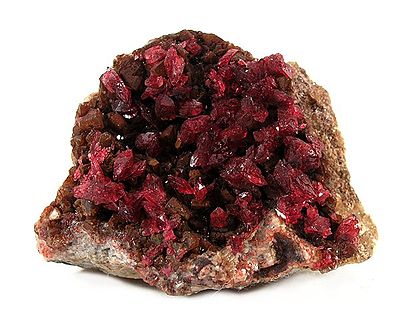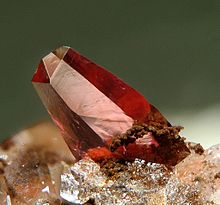Roselith
| Roselith | |
|---|---|
| Roselith specimen from Bou Azzer , Ouarzazate Province , Morocco (size: 4.9 × 3.6 × 2.2 cm) | |
| General and classification | |
| other names |
Roselite |
| chemical formula |
|
|
Mineral class (and possibly department) |
Phosphates, arsenates and vanadates |
|
System no. to Strunz and to Dana |
8.CG.10 ( 8th edition : VII / C.17) 02/40/03/01 |
| Similar minerals | Erythrin |
| Crystallographic Data | |
| Crystal system | monoclinic |
| Crystal class ; symbol | monoclinic prismatic; 2 / m |
| Space group | P 2 1 / c (No. 14) |
| Lattice parameters |
a = 5.80 Å ; b = 12.90 Å; c = 5.62 Å β = 107.4 ° |
| Formula units | Z = 2 |
| Frequent crystal faces | {011}, { 1 11}, {010}, {110} |
| Twinning | after {100} contact twins and quadruplets |
| Physical Properties | |
| Mohs hardness | 3.5 |
| Density (g / cm 3 ) | measured: 3.46 to 3.74; calculated: 3.65 |
| Cleavage | completely after {010} |
| colour | light to dark pink, rose red |
| Line color | pale red |
| transparency | transparent to translucent |
| shine | Glass gloss |
| Crystal optics | |
| Refractive indices |
n α = 1.725 n β = 1.728 n γ = 1.735 |
| Birefringence | δ = 0.010 |
| Optical character | biaxial negative |
| Axis angle | 2V = 68 ° (calculated) |
Roselith is a very rarely occurring mineral from the mineral class of " phosphates , arsenates and vanadates ". It crystallizes in the monoclinic crystal system with the idealized chemical composition Ca 2 Co [AsO 4 ] 2 · 2H 2 O, so it is chemically a water-containing calcium - cobalt arsenate.
Roselith is the cobalt analogue of wendwilsonite (Ca 2 Mg [AsO 4 ] 2 · 2H 2 O) and forms a complete mixed crystal row with it . In natural Roselith, therefore, a small proportion of cobalt is usually replaced ( substituted ) by magnesium , which is expressed in the formula with element symbols in round brackets: Ca 2 (Co, Mg) [AsO 4 ] 2 · 2H 2 O
The mineral usually develops short prismatic crystals from a few millimeters to a little over a centimeter in length, but is also found in the form of spherulitic or granular aggregates or embedded in geodes and druses . The color of the transparent to translucent crystals varies depending on the cobalt content between light and dark pink to rose red and becomes darker the higher the cobalt content.
Etymology and history
Roselith was first described in 1824 by Armand Lévy , who found the mineral on a piece from the collection of Charles Hampden Turner and named it after the German mineralogist Gustav Rose . The chemical analysis was carried out by John George Children , but could not determine the exact chemical composition due to the small amount of sample.
A more detailed analysis of the mineral was only possible through further discoveries in the ore mines of Schneeberg in the Saxon Ore Mountains in 1873/74 , namely the "Daniel" and "Rappold" mines. The latter, however, provided significantly more cobalt-rich, dark rose-red crystals and is therefore generally regarded as the type locality for the Roselith.
classification
In the meanwhile outdated, but still in use 8th edition of the mineral classification according to Strunz , the Roselith belonged to the department of "Water-containing phosphates without foreign anions ", where together with Fairfieldit it formed the "Fairfieldite Roselith Group" with system no. VII / C.17 and the other members brandtite , cassidyite , roselith-β , collinsite , gaitite , hillite , messelite , parabrandtite , talmessite , wendwilsonite and zinc roselite .
The 9th edition of Strunz's mineral systematics , which has been in effect since 2001 and is used by the International Mineralogical Association (IMA), also assigns the Roselith to the category of “phosphates etc. without additional anions; with H 2 O “. However, this is further subdivided according to the relative size of the cations involved and the molar ratio of phosphate, arsenate or vanadate complex (RO 4 ) to water of crystallization , so that the mineral is classified in the sub-section “With large and medium-sized cations; RO 4 : H 2 O = 1: 1 "is to be found, where the" Roselite group "with the system number is only found together with brandtite, wendwilsonite and zinc roselite. 8.CG.10 forms.
The systematics of minerals according to Dana , which is mainly used in the English-speaking world , assigns the Roselith to the class of "phosphates, arsenates and vanadates" and there in the department of "water-containing phosphates etc.". Here he is the namesake of the " Roselith subgroup (Monocline: P 2 1 / c ) " with the system no. 40.02.03 and the other members Brandtite, Manganlotharmeyerite , Wendwilsonite and Zinc Roselite can be found in the sub-section " Hydrous phosphates etc., with A 2+ (B 2+ ) 2 (XO 4 ) × x (H 2 O)".
Crystal structure
Roselith crystallizes isotypically with Fairfieldite in the monoclinic crystal system in the space group P 2 1 / c (space group no. 14) with the lattice parameters a = 5.80 Å ; b = 12.90 Å; c = 5.62 Å and β = 107.4 ° and 2 formula units per unit cell .
properties
Roselith is very similar in color to erythrin , but can be distinguished from it by heating it in a glass tube. Roselith changes its color in a characteristic way, initially to a strong glaze blue ( ultramarine ) and, after cooling completely, to lavender blue . Erythrin ( cobalt blossom ), on the other hand, only takes on a bluish-black appearance.
Education and Locations

Roselith forms secondarily in cobalt-containing, hydrothermal deposits . As accessory mineral occurs among other Talmessit on.
As a rare mineral formation, Roselith could only be proven at a few sites, whereby so far (as of 2013) around 20 sites are known. In addition to its type locality “Grube Rappold”, the mineral also appeared in other pits of the Marx-Semler-Stolln system around Neustädtel in the Schneeberg district in Saxony, the “Friedrich-Christian” pits in Wildschapbachtal and “St. Anton ”in the Heubachtal in Baden-Württemberg, near Mackenheim and in the Richelsdorf district in Hesse and in the“ Grüne Aus ”mine near Schutzbach in Rhineland-Palatinate.
A well-known location for roselith are the deposits around Bou Azzer ( Bou Azer ) near Tazenakht in the Moroccan province of Ouarzazate , where rich cobalt, silver and nickel ores are mined in over 80 open-cast and underground mines and many beautiful roselith specimens have also come to light . However, since the similarly colored minerals erythrin and wendwilsonite also occur in Bou Azzer, the risk of confusion is correspondingly high, especially since wendwilsonite as a mixed crystal partner is virtually indistinguishable from roselite due to its chemical similarity.
Other sites include the “Veta Negra Mine” in the Pampa Larga District (Tierra Amarilla) in the Chilean province of Copiapó , the “Talmessi Mine” near Anarak in the Iranian province of Esfahan and the “Silvana Mine” near Sandon in the Canadian province of British Columbia .
See also
literature
- A. Lévy: Account of a new Mineral Substance . In: Annals of Philosophy . tape 8 , 1824, p. 439–441 ( strahlen.org [PDF; 425 kB ]).
- JG Children: Chemical Examination of Roselite . In: Annals of Philosophy . tape 8 , 1824, p. 4441-442 ( strahlen.org [PDF; 465 kB ]).
- Friedrich Klockmann : Klockmann's textbook of mineralogy . Ed .: Paul Ramdohr , Hugo Strunz . 16th edition. Enke, Stuttgart 1978, ISBN 3-432-82986-8 , pp. 645 (first edition: 1891).
- Hans Jürgen Rösler : Textbook of Mineralogy . 4th revised and expanded edition. German publishing house for basic industry (VEB), Leipzig 1987, ISBN 3-342-00288-3 , p. 639 .
Web links
- Mineral Atlas: Roselith (Wiki)
- Thomas Witzke : Discovery of Schörl. Retrieved May 5, 2013 .
- Database-of-Raman-spectroscopy - Roselite. Retrieved May 5, 2013 .
Individual evidence
- ↑ a b c IMA / CNMNC List of Mineral Names 2009 (PDF; 1.8 MB).
- ↑ a b c d e Hugo Strunz , Ernest H. Nickel : Strunz Mineralogical Tables. Chemical-structural Mineral Classification System . 9th edition. E. Schweizerbart'sche Verlagbuchhandlung (Nägele and Obermiller), Stuttgart 2001, ISBN 3-510-65188-X , p. 484 .
- ↑ Webmineral - Rose Lite.
- ↑ a b Roselite . In: John W. Anthony, Richard A. Bideaux, Kenneth W. Bladh, Monte C. Nichols (Eds.): Handbook of Mineralogy, Mineralogical Society of America . 2001 ( handbookofmineralogy.org [PDF; 64 kB ; accessed on May 21, 2017]).
- ↑ Stefan Weiß: The large Lapis mineral directory. All minerals from A - Z and their properties . 6th completely revised and supplemented edition. Weise, Munich 2014, ISBN 978-3-921656-80-8 .
- ↑ a b c d e Mindat - Roselite.
- ^ The Mineralogical Record - Armand Lévy (1795–1841).
- ^ A. Weisbach : Mineralogical notes. 1. Pucherite. 2. Domeykit. 3. Rhagit. 4. Roselith . In: Yearbook for mining and metallurgy in the Kingdom of Saxony . 1874, p. 249–254 ( strahlen.org [PDF; 405 kB ; accessed on May 21, 2017]).
- ↑ Mineral discovery site Bou Azzer district, Morocco at the Mineralienatlas and at Mindat .
- ↑ Find location list for Roselith at the Mineralienatlas and at Mindat


